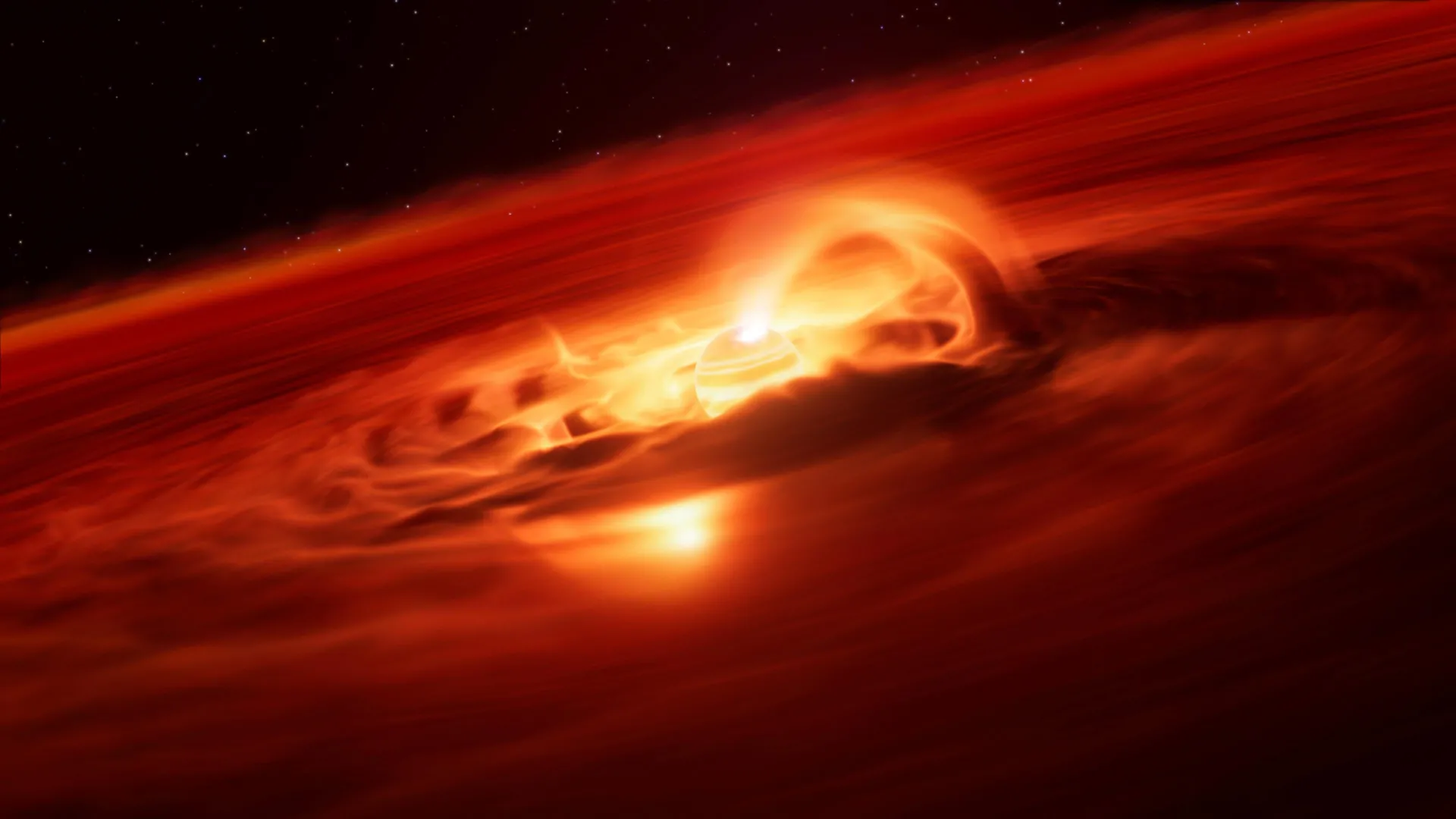Rogue planet spotted devouring 6 billion tons every second
A rogue planet is feasting like a star, rewriting the rules of planetary birth.
- Date:
- October 3, 2025
- Source:
- ESO
- Summary:
- Astronomers have uncovered a runaway feeding frenzy in a rogue planet drifting freely through space, devouring six billion tonnes of gas and dust every second. Located 620 light-years away in the Chamaeleon constellation, the object, Cha 1107-7626, is growing at the fastest rate ever seen in any planet. The dramatic surge in mass revealed evidence of strong magnetic fields and changing chemistry, including water vapor, previously only observed in young stars.
- Share:

Astronomers have observed an extraordinary "growth spurt" in a mysterious type of world known as a rogue planet. Unlike the planets in our Solar System, these cosmic wanderers drift through space on their own rather than orbiting a star. Using the European Southern Observatory's Very Large Telescope (ESO's VLT), scientists discovered that one of these planets is rapidly consuming gas and dust from its surroundings at an astonishing rate of six billion tonnes per second. This marks the most extreme growth ever recorded for a rogue planet -- or any planet -- offering valuable clues about how such free-floating worlds form and evolve.
"People may think of planets as quiet and stable worlds, but with this discovery we see that planetary-mass objects freely floating in space can be exciting places," says Víctor Almendros-Abad, an astronomer at the Astronomical Observatory of Palermo, National Institute for Astrophysics (INAF), Italy and lead author of the new study.
A Giant Taking Shape in the Chamaeleon Constellation
The planet, named Cha 1107-7626, lies roughly 620 light-years away in the constellation Chamaeleon and is estimated to be five to ten times more massive than Jupiter. Still in its formative stage, it is surrounded by a swirling disc of gas and dust that continually feeds it through a process known as accretion. However, Almendros-Abad and his team found that this feeding is not steady -- the planet's intake rate can dramatically fluctuate over time.
By August 2025, the planet's growth had accelerated nearly eightfold compared to only a few months earlier, reaching the record pace of six billion tonnes per second. "This is the strongest accretion episode ever recorded for a planetary-mass object," says Almendros-Abad. The discovery, published on October 2 in The Astrophysical Journal Letters, was made with the X-shooter spectrograph on ESO's VLT in Chile's Atacama Desert. The researchers also drew on data from the James Webb Space Telescope, operated by the US, European, and Canadian space agencies, and archival data from the SINFONI spectrograph on ESO's VLT.
"The origin of rogue planets remains an open question: are they the lowest-mass objects formed like stars, or giant planets ejected from their birth systems?" asks co-author Aleks Scholz, an astronomer at the University of St Andrews, United Kingdom. The findings indicate that at least some rogue planets may share a similar formation path to stars since similar bursts of accretion have been spotted in young stars before. As co-author Belinda Damian, also an astronomer at the University of St Andrews, explains: "This discovery blurs the line between stars and planets and gives us a sneak peek into the earliest formation periods of rogue planets."
Powerful Magnetic Fields and Changing Chemistry
By comparing the light from the planet before and during the accretion burst, the researchers gained insight into the processes driving the event. They found evidence that magnetic forces likely contributed to the dramatic inflow of material -- a phenomenon previously seen only in stars. This means even low-mass planetary objects can have strong magnetic fields capable of fueling such powerful growth episodes. The team also noticed changes in the composition of the planet's disc during the burst, detecting water vapor that was not present beforehand. Such behavior had been documented in stars but never in a planet until now.
Detecting free-floating planets is notoriously challenging because they are faint and isolated, but future observatories are expected to change that. ESO's upcoming Extremely Large Telescope (ELT), equipped with advanced instruments and operating under some of the world's darkest skies, will make it possible to identify and study more of these solitary worlds. "The idea that a planetary object can behave like a star is awe-inspiring and invites us to wonder what worlds beyond our own could be like during their nascent stages," says co-author and ESO astronomer Amelia Bayo.
The study was carried out by V. Almendros-Abad (Istituto Nazionale di Astrofisica -- Osservatorio Astronomico di Palermo, Italy), Aleks Scholz (School of Physics & Astronomy, University of St Andrews, United Kingdom [St Andrews]), Belinda Damian (St Andrews), Ray Jayawardhana (Department of Physics & Astronomy, Johns Hopkins University, USA [JHU]), Amelia Bayo (European Southern Observatory, Germany), Laura Flagg (JHU), Koraljka Mužić (Instituto de Astrofísica e Ciências do Espaço, Faculdade de Ciências, Universidade de Lisboa, Portugal), Antonella Natta (School of Cosmic Physics, Dublin Institute for Advanced Studies and University College Dublin, Ireland), Paola Pinilla (Mullard Space Science Laboratory, University College London, UK), and Leonardo Testi (Dipartimento di Fisica e Astronomia, Università di Bologna, Italy).
Story Source:
Materials provided by ESO. Note: Content may be edited for style and length.
Journal Reference:
- Victor Almendros-Abad, Aleks Scholz, Belinda Damian, Ray Jayawardhana, Amelia Bayo, Laura Flagg, Koraljka Mužić, Antonella Natta, Paola Pinilla, Leonardo Testi. Discovery of an Accretion Burst in a Free-floating Planetary-mass Object. The Astrophysical Journal Letters, 2025; 992 (1): L2 DOI: 10.3847/2041-8213/ae09a8
Cite This Page: